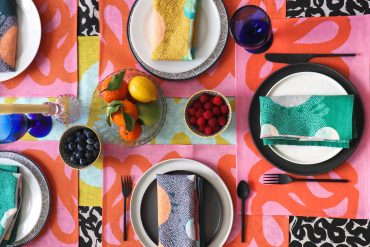As I mentioned in Part 1, there are some common themes that run through all of the Russian folk styles – overwhelmingly there are references to nature, with leaves, fruit, and flowers as the most popular motifs for their associations with happiness and plenty. Birds of various kinds run a close second – roosters are chosen for their virility, doves for their peacefulness; but also included are mythological creatures, such as the firebird, whose magical feathers can light up a large room, and with its song, can make the land bloom.
The firebird is a particularly popular motif in Khokhloma decoration, as the style’s restricted palette of distinctive colours are ideally suited to it – rich red and gold on a black background. It is a style that is thought to originate from the 17th C in Central Russia, in a trading settlement that bore its name.
The lush patterns are typically used to decorate wooden tableware, such as spoons, plates and cups. In traditionally made pieces, the gold colour actually starts out silver, as the paint is made from powdered tin. It is then over-painted with red and black before being finished with several layers of lacquer; this provides the golden hues, as well as giving the piece a lustrous polish.
Even though the colours used are flat, the style is sumptuous, partly of course from the gold and lustrous surfaces, but it is also achieved through a combination of densely packed elements, sensuous forms, and given depth and tone through the gradations of line.
{images clockwise from top left: 1. lidded container – http://timebanditvintage.etsy.com; 2. bowl – http://domusdecorus.etsy.com; 3. bowl – http://retroisin.etsy.com; 4. bowl – http://dimitrijnigodoff.etsy.com; 5. tray – http://lazycatdesignz.etsy.com }
Perhaps it was to do with the end products being decorated, or perhaps it was just a matter of taste, but it was only a few miles away from Khokhloma in yet another village that the Gorodets style became popular, where it was generally used to decorate distaffs (a tool used in spinning), and dough boards for the kitchen.
Gorodets concentrated more on genre scenes, featuring central motifs of birds and animals, or sometimes people on horseback, framed by sprays of flowers. It is much lighter and more colourful, and although there is still lots of red, it also includes bright pastels of multiple hues on pale or white backgrounds. The flat colours are still there, as are the linear elements of varying thicknesses, and the teardrop-shaped brushstroke is used throughout. Flowers are often constructed from concentric bands of different patterns, and symmetry is also a common device, either in individual motifs, or on the overall design of the painting.
{images clockwise from top left: 1. http://joyfool.etsy.com; 2. http://priyanikandcookie.etsy.com; 3. http://joyfool.etsy.com 4. http://priyanikandcookie.etsy.com}
Series on the history of surface design by Julie Gibbons. Explore Part Three of this series here.













